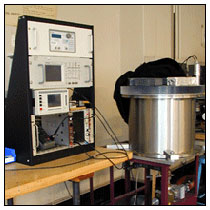|


The scattering of alpha particles
by nuclei. Nearly monoenergetic alpha particles
(He nuclei) in a collimated beam from an source
are scattered from thin foils of gold or titanium,
and the intensities of the scattered alpha particles
are measured with a silicon barrier detector at
various scattering angles.
The energies of the incident
alpha particles can be reduced by placing a gold
foil in the beam. The differential scattering
cross section of the target atoms is measured
as a function of the angle of scattering, the
energy of the particles, and the nuclear charge
of the target atoms. The results are compared
with the Rutherford theory of scattering by atomic
nuclei.
Student Wiki: Rutherford Scattering
Download
Lab Guide in PDF format
(certificates
required)

- E. Rutherford, "The Scattering of alpha and beta Particles by Matter and the Structure of the Atom," Philos. Mag., 669-688 (1911).
- Geiger, H, "The Scattering of the ?-Particles by Matter", Proceedings of the Royal Society of London. Series A, Containing Papers of a Mathematical and Physical Character, Vol. 83, No. 565. (Apr. 14, 1910), pp. 492-504.
- J.L. Eisberg, Fundamentals of Modern Physics, (Wiley, New York, 1961), "The Discovery of the Atomic Nucleus," pp. 87-109.
- A.C. Melissinos, Experiments in Modern Physics, (Academic Press, San Diego, 1966), "Solid-State Particle Detectors," pp. 208-217.
- A.C. Melissinos, Experiments in Modern Physics, (Academic Press, San Diego, 1966), "Rutherford Scattering," pp. 226-252.
- E. Segre, Nuclei and Particles, (W.A. Benjamin, Reading, MA 1977), Ch 2: "The Passage of Radiations through Matter," pp. 17-36.
- S. Gasiorowiez, Quantum Physics (John Wiley, Hoboken, 2003), "The Born Approximation," pp. 302-305.
- Gasiorowiez, "The Absorption of
Radiation in Matter", Quantum Physics,p. 416-419

- Stopping
Power and Range Tables for Helium Ions
-
Maestro software user manual
- Through The Wormhole:
What are we Really Made of? MIT professor Steve Nahn discussing the experiment.
|